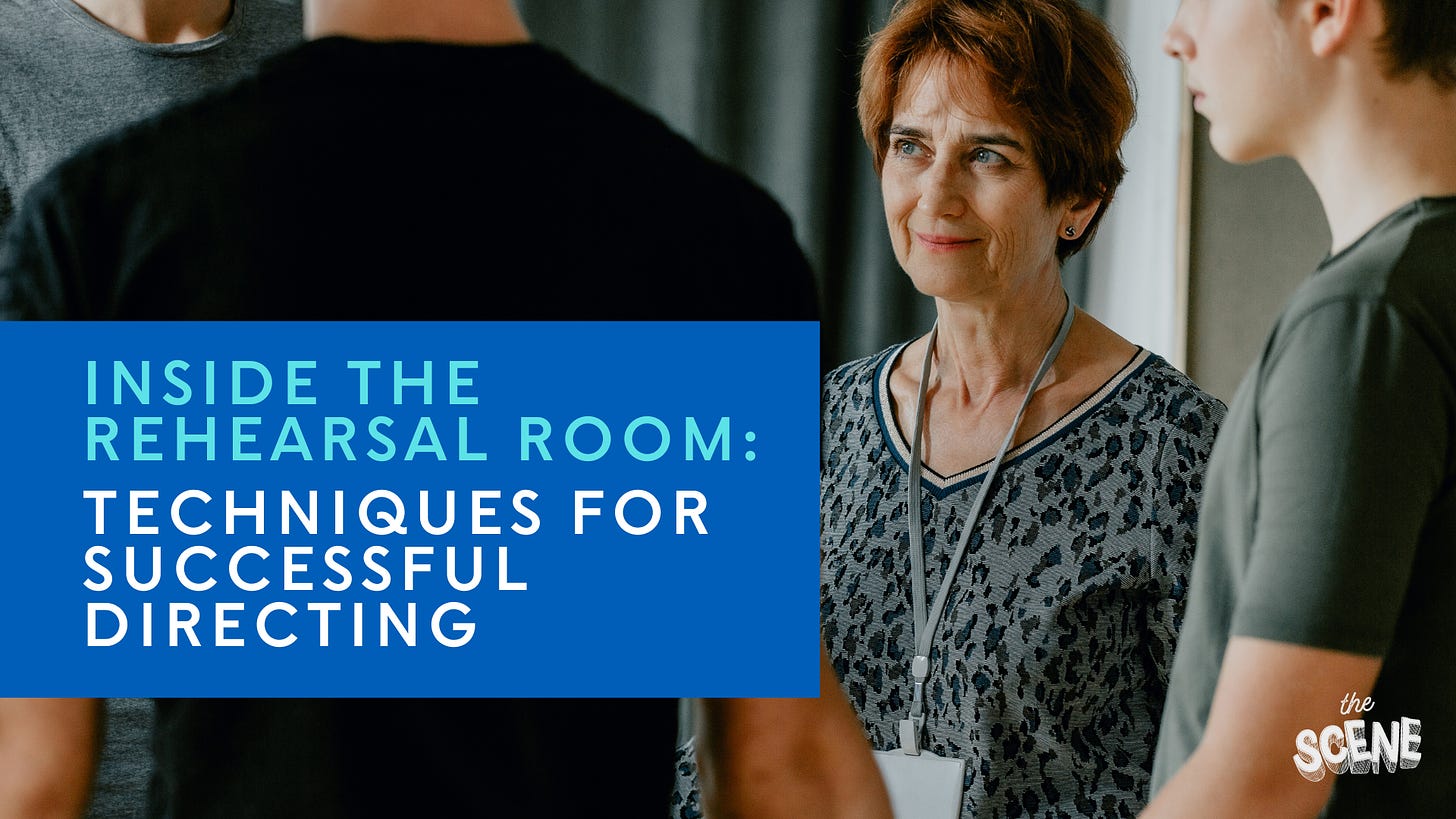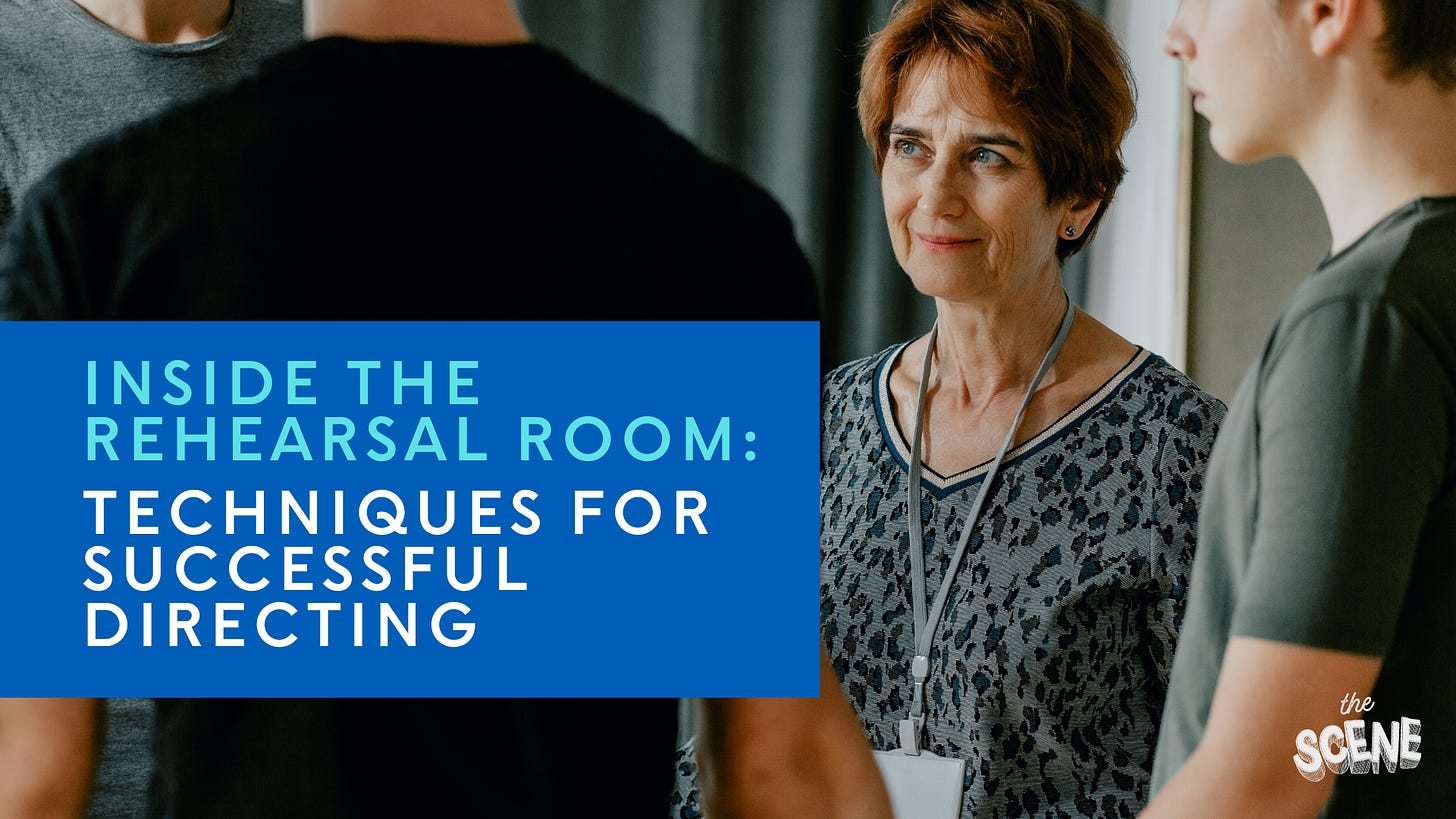Inside the Rehearsal Room: Techniques for Successful Directing
Plus, your weekly round-up of theatre news you may have missed!
Welcome to The Scene, your weekly round-up of theatre news you may have missed. In this week's email,
We discuss techniques educators can use when directing their next theatre production.
So, raise the curtain, shine the spotlight, and dive into another thrilling week in the theatre world. Welcome to The Scene.
John Mulaney, Renée Elise Goldsberry, More Are Bringing Short Stories by Simon Rich to Broadway by Logan Culwell-Block, Playbill | A cast of comic icons—also including Fred Armisen, Chloe Fineman, and Richard Kind—will star in ‘All In: Comedy About Love’ at the Hudson Theatre this year. Read...
Yesterday’s Broadway Warhorses, Saddled With Today’s Concerns by Jesse Green, The New York Times | Revivals of “Romeo and Juliet,” “Our Town,” “Gypsy” and “Sunset Boulevard” aim to show that rethinking for the present is what makes classics classic. Read...
'One of the Greats,' 'An Actor's Actor': Broadway Pays Tribute to the Legacy of James Earl Jones by Logan Culwell-Block, Playbill | The EGOT-winning stage and screen icon died on September 9 at 93. Read...
Hollywood Is Heading for Broadway (and Off). Here’s a Cheat Sheet by Michael Paulson, The New York Times | George Clooney as Murrow! Denzel Washington as Othello! Mia Farrow as a larcenous landlord! So much to see! Read...
Where Did the Actors of the 2023–24 Broadway Season Go to School? by The Playbill Staff, Playbill | Here are the top 10 universities for the current crop of Broadway actors. Read...
Where Did the Creatives of the 2023–24 Broadway Season Go to School? by The Playbill Staff, Playbill | Here are the top 10 universities for the current crop of Broadway playwrights, directors, designers, and composers. Read...
8 Broadway Stars Without Theatre Degrees by Molly Higgins, Playbill | While back-to-school season means plenty of talk about BFAs, these stars are proof that there are many different paths to the stage. Read...
25 Broadway Professionals Share Their Training by Andrew Gans, Playbill | A mix of actors, designers, directors, and stage managers recall the schools that were part of their journey to the Main Stem. Read...
Inside the Rehearsal Room: Techniques for Successful Directing
By Zach Dulli, The Scene
When the lights dim and the curtain rises, the audience is transported into a world of seamless movement, raw emotion, and compelling storytelling. But behind every captivating performance is a director who has painstakingly orchestrated the action in the rehearsal room. For theater teachers, balancing the art of directing with the practicalities of managing student actors can be a challenge. Luckily, with the proper techniques, you can guide your cast to success while fostering an environment of growth and creativity.
Here’s your guide to effective directing strategies that will help you block, develop characters, and manage rehearsals like a pro.
The Art of Blocking: Movement as Meaning
Blocking goes beyond simple stage positioning. It’s a key part of visual storytelling, helping to communicate the relationships between characters and the emotional beats of the play. Every movement on stage should serve the story, so think of blocking as choreography with intention.
One effective technique is “image-based” blocking. Before diving into a scene, ask your actors to create a freeze-frame representing the core conflict or theme. This helps them think about how their physical positions contribute to the story and gives you a powerful starting point for building the scene. Encourage your actors to think about how proximity, posture, and levels on stage—whether someone is sitting, standing, or even lying down—convey subtext.
However, beware of over-blocking as well. Too much rigidity can stifle creativity and make the performance feel mechanical. Instead, give your actors guidelines but allow room for natural movement, i.e., structured freedom. When actors feel free to explore their space within the framework you've set, their performances often become more spontaneous and authentic.
Character Development: Beyond the Script
For many young actors, stepping into a character’s shoes can be daunting. They might focus on memorizing lines without genuinely understanding the motivation behind their words. That’s where you come in. As a director, your role is to help actors dig deeper into their characters’ desires, fears, and journeys.
A great starting point is encouraging your actors to ask two key questions: “What does my character want at the beginning of the scene?” and “How has that changed by the end?” This simple exercise can lead to profound insights into character motivations and relationships.
Improv exercises can also be a game-changer. Try having your actors improvise scenes that take place before or after the events of the play. By imagining their character’s life outside the script, they can discover new dimensions to their role. Improv encourages your students to think on their feet and stay present in the moment, which ultimately enhances the authenticity of their performance.
Rehearsal Management: Keeping the Chaos Under Control
Rehearsals, especially in a school setting, can quickly descend into chaos if not properly managed. Students have busy schedules, and keeping everyone on task can feel like herding cats. The key to a productive rehearsal is organization—and a dash of flexibility.
Start by creating a detailed rehearsal schedule and sharing it with your cast and crew. When everyone knows what to expect, it minimizes downtime and keeps the momentum going. But don’t be afraid to adjust on the fly. If a scene needs more attention or an actor struggles with a specific moment, be prepared to pivot your schedule to address these issues.
Breaking your cast into smaller groups is another effective way to maximize rehearsal time. Rather than having everyone sit idle while one scene is being rehearsed, assign different groups to work on different parts of the play simultaneously. This keeps energy levels high and allows for more focused attention in each rehearsal block.
It’s also crucial to foster an environment where your actors feel safe to experiment. Rehearsals should be a space for trial and error, where actors can make bold choices without fear of failure. Encourage your cast to take risks and try different approaches to their scenes—often, the most unexpected choices lead to the most powerful moments on stage.
Collaboration is Key: Empowering Your Cast and Crew
Theater is a collaborative art, and as a director, you’re the conductor of that collaboration. While it’s important to have a clear vision for the production, don’t be afraid to involve your cast and crew in the creative process. When students feel they have a stake in the production, they’re more engaged and invested in the final product.
Invite your actors to offer feedback on their characters or suggest adjustments to blocking that feel more natural to them. Likewise, involve your tech crew in creative problem-solving—whether it’s figuring out set design, props, or lighting. Empowering your students not only builds a sense of ownership but also strengthens the overall production by incorporating a variety of perspectives.
The Bottom Line: Enjoy the Journey
Directing is an art that combines leadership, creativity, and collaboration. For theater teachers, it’s also about guiding your students through a learning process that is both challenging and rewarding. At the end of the day, the goal isn’t just to put on a great show—it’s to foster a love for the craft and create an environment where your students feel inspired to grow as artists.
So, while it’s important to focus on clean blocking, deep character work, and a well-run rehearsal process, remember to keep it fun. Theater should be a joyful experience, both for you and your students. If you’re enjoying the process, your cast will, too—and that energy will shine through in the final performance.
‘The Play That Goes Wrong’ extends West End run into 2026 by Tom Millward, WhatsOnStage | The award-winning comedy celebrated its tenth anniversary at the Duchess Theatre last night. Read...
‘Frozen’ Closes in London's West End by Andrew Gans, Playbill | The Disney musical opened at the Theatre Royal Drury Lane in 2021. Read...
North By Northwest to be adapted for the stage by Wise Children by Alex Wood, WhatsOnStage | The Alfred Hitchcock classic is getting the theatre treatment! Read...
David Oyelowo Leads Lyndsey Turner-Helmed ‘Coriolanus’ at London's National by Logan Culwell-Block, Playbill | The film star is making his National Theatre debut with the performance. Read...
National Tour of ‘Harry Potter and the Cursed Child’ Launches in Chicago by Andrew Gans, Playbill | The tour of the international hit kicks off at the James M. Nederlander Theatre. Read...
Immersive ‘The Outsiders’ Production to Play Chicago by Margaret Hall, Playbill | Adapted by Christopher Sergel from the modern classic by S.E. Hinton, this is a play version of the coming-of-age tale. Read...
Caitlin Houlahan, Chris McCarrell, Karen Ziemba Lead ‘Prelude to a Kiss’ Musical by Andrew Gans, Playbill | The new musical plays Milwaukee Repertory Theater following its April world premiere at South Coast Repertory. Read...
‘Bull Durham, A New Musical’ Begins Performances by Margaret Hall, Playbill | Starring Carmen Cusack, Nik Walker, and John Behlmann, this is a reworked adaptation with eyes on New York following the southern tryout. Read...
Free Reads of the Week
Read entire plays for free! Playscripts offers a selection of full-length and one-act plays that you can access for free, which is ideal for use in theatre productions, school performances, or competitions. To explore these titles, click on the cover image below or select the "READ FOR FREE" button at the bottom of this section. This action will direct you to the play's page on the Playscripts website. Once there, click "READ NOW" to begin enjoying the play immediately!
4 A.M. by Jonathan Dorf
The Story: What's it like to be awake when the rest of your world is asleep? Meet an early-morning jogger, a radio DJ whose show may have an audience of none, a modern Romeo and Juliet, the author of a most unusual letter, and many other teen characters as they search for connection in the magic hour. Through a series of connected scenes and monologues, join them on their journey as they discover whether the monster under the bed is real and collectively wonder...is there anybody out there?
Dramedy | 30 - 35 minutes | 3 W, 3 M, 6 Any (6-40 actors possible: 3-20 W, 3-20 M) | Set: Minimal -- various suggested interiors, as well as a suggested exterior.












